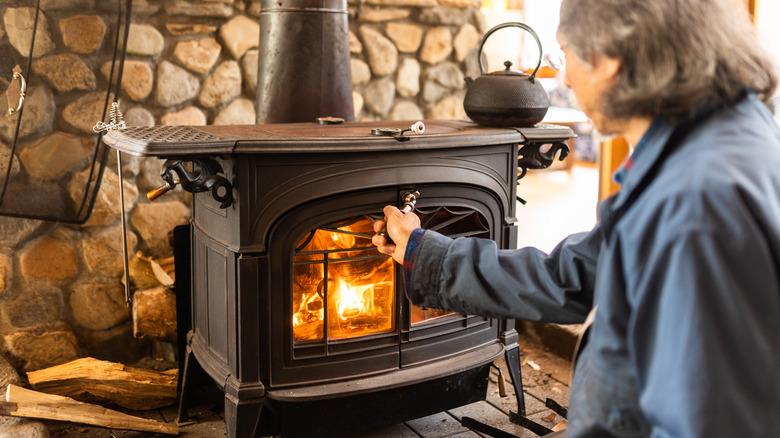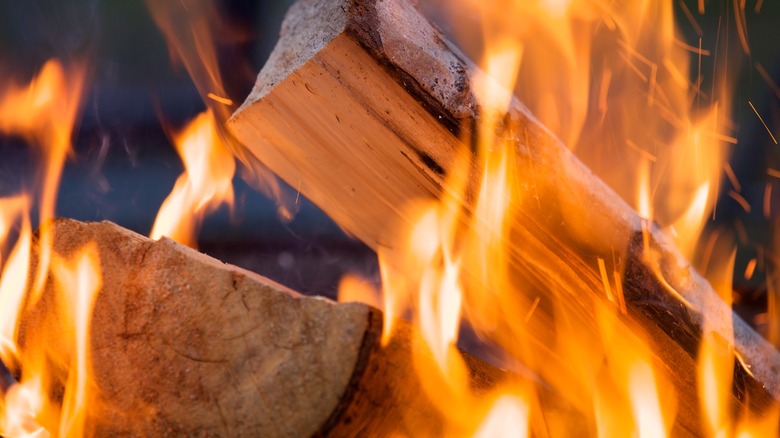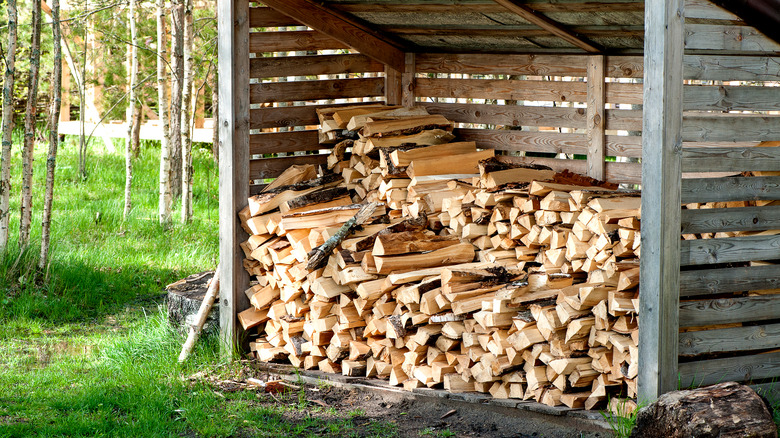Is It Okay To Burn Pine In Your Wood-Burning Stove?
We may receive a commission on purchases made from links.
Confusing advice abounds about the suitability of pine trees for firewood. This fast-growing timber has been a popular choice for wood stoves and fireplaces throughout the ages and worldwide. In pre-electricity Britain, for example, it was a go-to fuel for household lighting and torches. Pine has gained a less-than-stellar reputation in the U.S. in the 20th and 21st centuries, though. Among other downsides, many claim the resinous softwood releases sap when burned, clogging chimneys and potentially creating a fire risk. This problem, however, is reduced or even negated if the logs are burned at high heat and are completely dry before they're chucked onto the fire — meaning, yes, it's okay to burn pine in a wood stove, so long as you stick to these rules.
A popular pine used for firewood in America is the Southern yellow pine (Pinus echinata), also known as shortleaf pine. This species puts off a high heat and burns and splits easily. It gives off moderate to heavy smoke and sparks (those crackling, popping sounds you sometimes hear a fire make) and has a high sap content. Other popular species include lodgepole and white pine — they're also classified as resinous softwoods but have lower heat values and overall quality (where burning is concerned) than yellow pine. So, what can pine do for your wood-burning stove needs?
The pros and cons of pine
Probably the most oft-mentioned concern regarding pine firewood is its high resin content. The sap from burning pine turns into creosote, a sticky, combustible tar. This highly flammable material builds up in the flue, along with soot. The creosote and soot layer ignites, causing a house fire. But is this cautionary tale accurate? Experts now lean toward no — or at least, not quite. Burn correctly seasoned (aka dried) pine in a well-ventilated, hot enough fire, and you'll avoid the release of creosote.
There are other issues to be aware of, though. Pine ash is feather-light and, similarly to the ash of burned paper, has been known to float out of the chimney and settle on the roof; it's a potential fire hazard. You also need a lot of firewood since pine burns quickly — it won't last a night. The cost and storage of larger timber volumes may be impractical for some homeowners.
Burning quickly isn't always a downside; you can use this trait to your advantage. Pine is a good fire starter, helping you take the edge off that chilly spring or fall morning fast. What's more, it doesn't overheat a home like longer, slower-burning hardwoods. Pine firewood may also be better for indoor air quality. A 2022 study published in the Journal of the Air & Waste Management Association found that Eastern white pine pellets had lower particulate matter emissions and ash production than their hardwood counterparts.
Sourcing and seasoning pine
You can buy pine firewood in a wide range of sizes — expect a 50-pound bag of Australian pine (which is, incidentally, less resinous than its U.S.-grown cousins) to cost well under $100; a full cord of pine could set you back closer to $300. Firewood delivery rates are typically calculated per mile, so it's best to look for a supplier near you. If you just need a small amount of pine, Walmart has a 25-pound box of indoor-outdoor pine fire starters for $48.72. They're as great for wood-burning stoves as for that tiny DIY firepit using a terracotta pot out on your patio.
Your pinewood's delivered, and the woodpile's stacked; time to brush up on pine firewood best practices to get the most out of your new home heating source. Damp timber — that is, wood with over 20% moisture — causes more creosote buildup than properly dried timber. Dry your split pine firewood for at least a season (say, spring through fall or at least six months), though some experts say one to two years is better.
If you're running an old wood-burning stove, consider upgrading. New-technology fireplaces are more efficient, allowing you to burn all kinds of species — correctly seasoned, of course — safely. And, as always, avoid using pressure-treated lumber or construction pine in your wood-burning stove; you'll release harmful chemicals into the air and your home.


